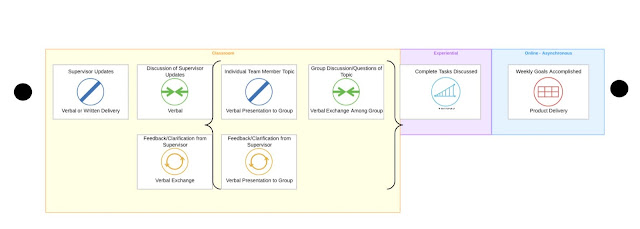Layers of a Weekly Team Meeting
August 30, 2016 - Brad GriffithI work on a team of individuals that handles strategy and program development for our organization. We meet on a weekly basis to get updates from our supervisor, each team member, and to solicit feedback and brainstorming in reference to our projects.
First, I have distinguished the following elements as outcomes of our meetings. From our meeting, we should be able to derive a list of tasks and collaborations that must take place between one meeting and the next. The final evidence block consists of the accomplished goals as seen through product delivery.
Next comes the strategy with how the learning environment helps people accomplish their list of tasks. There seems to be an even distribution of content, dialogue, and feedback, with the practice element consisting of deriving tasks from the discussions. One person presents their topic, followed by the group or supervisor discussion and feedback.
The system layer of this learning environment provides the structure for our meeting. It begins with the supervisor discussing important topics, followed by employees doing the same in a F2F/classroom setting. The repeat loop can occur as many times as is needed for each employee to be able to communicate information. I listed the practice block as experiential since it can occur in a variety of ways, while I listed the evidence block (or product) as online asynchronous due to our existence as an eLearning organization that presents primarily virtual products.
The addition of the experience layer brings into clear view how the learners and supervisor will interact in this learning environment. The supervisor sets the stage by communicating the most important organization-wide information first. There is always opportunity given for feedback and discussion at this point to gain clarification on any goals within that content. Following, the individual team members present information and receive feedback from the supervisor before opening up the floor to discussion. This pattern within the learning environment repeats as many times are needed to cycle through each team member. Once the discussion has concluded, each employee defines specific tasks to accomplish in order to deliver the products or services promised by the team.
In conclusion...
I found this approach to be exciting and one that honestly made the experience of learning environment modeling one that was more tangible. I used the questions associated with each layer to come up with these blocks and appreciated seeing how it all connected together at the end. This was also my first foray into digital modeling and I think dissecting this environment through its layers provided me with an easier approach to entering this on a computer.I thought much more strategically about how the structure is laid out and why. I think considering these layers also has ties to principles of design thinking; we should all strive for empathy for the user when constructing learning environments.




